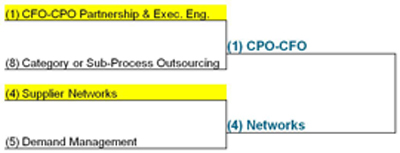What is the best CPO tool or strategy in 2012?
Our field of 32 determines this year’s champion
Yes folks, it’s March Madness, Chief Procurement Officer Style, where the different procurement tools and strategies compete to get to the CPO’s Final Four.
Ball so Hard!
The CPO Rising Tourney moves from Orlando to Caracas (why not?) for Region Two and another exciting two-day drama-fest matching 8 of the sharpest tools in the CPO’s toolbox.
Region One’s action included a drubbing led by eSourcing which barely broke a sweat to advance and one Cinderella story coming to life before our eyes (Contract Compliance).
Thanks for joining us on Day 3 / Gracias por acompañarnos en el día 3 (we are, after all in Caracas)
Before we start, I’ll note a few things:
(1) Thank you for playing along with us! When this Tourney began, we weren’t sure what was going to happen or what approach we’d take. We still don’t know how this is going to turn out, but I do think that next week we will speed up the play and cover more games, more quickly.
(2) We’ve taken a different tone with the CPO Bracketology than with other series/topics on CPO Rising. We hope you find this entertaining. If you’d prefer to read a more serious discussion, try this Top 10 series or this one on Technology Adoption to start.
(3) Ball so Hard!
Region Two – (1) CFO-CPO Partnership & Exec. Eng. vs. (8) Category or Sub-Process Outsourcing
Though some tools are just happy to be here, Category and Sub-process Outsourcing (“CSO”) is more than a little annoyed. First they questioned their seeding (8th?!?) asking the Tournament Selection Committee if it got confused and thought this was 2004, not 2012, where a significant momentum has been building behind the strategy over the past two or three years among CPOs vying for transformation, yet
constrained by hiring freezes and those CPOs greeting pressure to look at their cost per managed spend and FTE per managed spend [Sidebar: We have seen some dubiously aggressive numbers flying around as “industry standard” since 2010, so we urge any and all CPOs to dig deeper and gain more validation than one Group’s view on World Class cost structures before making any big decisions].
CSO also questioned why it’s lumped in with outsourcing activities like PO processing and eSourcing supplier training – it views itself as uniquely strategic – with its orientation of bringing in specialists to set and oversee category strategies and then utilizing lower cost resources to drive them – when compared to process outsourcing.
Fair points, unfortunately for CSO, here’s how its opponent weighed in:
“The CFO-CPO relationship might be the most important relationship that exists or needs to exist within the enterprise.” John Paterson
“If our savings does not impact the budget, we do not count it. We never consider including cost avoidance in our group savings metrics, it would undercut our credibility with the CFO.” Jean-Jacques Beaussart
“For an enterprise to achieve operational excellence within procurement AND finance, the CPO and CFO must enjoy the benefits of a healthy inter-departmental partnership and achieve alignment on savings, cash management, and procurement performance.” Ardent Partners – The CFO and the CPO: One World, Two Worldviews
Game, set, and match to “CPO-CFO/Exec. Engagement.”
Region Two – (4) Supplier Networks vs. (5) Demand Management
Another gritty 4 v. 5 classic between new school (the white-hot Supplier/Payment Networks) and old school (the Zelig-esque strategy, Demand Management).
Though they were introduced in the late 1990’s during the rise of B2B Marketplaces, it’s only recently that Supplier Networks have started to get their act together and play with some “swagger” (Ball so Hard!).
Transactional efficiencies are a benefit that have been there since the start and they are nothing to scoff it. But it has only been more recently that some networks began to deliver much more than that. Today, some Supplier Networks have grown to a point where a true ‘network effect‘ occurs amongst the participants, creating interesting opportunities for buyers and suppliers in the near-term and unleashing a grand, but as yet, still undefined vision of a future place where buyers and suppliers do extraordinary things.
The Networks’ adversary today, Demand Management, is another one of those CPO tools that is accessible to the “common man” (the common man, in this case, is defined as someone who, after meeting you at the cocktail party says, “I’m sorry, you say you work in procurement, but what does that actually mean?”). Here’s what I mean –
“The best way to save money, is not to spend it.” Will Rogers Mark Twain Poor Richard’s Almanac every CPO
You can’t argue with that strategy nor do you want to.
Demand Management is also the beneficiary of what could be called the “procurement’s about much more than savings” narrative that we all use and believe. DM is often that third or fourth tool tossed into the bouillabaisse of CPO Strategic value – “sure we save money but we also manage quality, mitigate supply risk, and set policies to manage demand.”
The promise of Demand Management is great, but the success stories we hear about it are often linked to sustainability and carbon footprints – So we won’t penalize demand management for its usage of another CPO Tool in this tournament (Sustainability), but we do penalize it for lacking a preponderance of real examples beyond ones like this: “We saved $8,000 on paper towels last year by asking our employees to shake their hands dry or use their socks.” DM needs to get its story straight.
Networks win easily.

